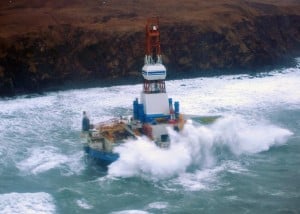
In a blow to environmentalists, the Obama administration gave conditional approval to oil giant Royal Dutch Shell to go ahead with drilling six exploratory oil wells in the Chukchi Sea.
The conditional approval by the Interior Department sets aside a major hurdle for the oil company as it continues with its plans for drilling in the U.S. Arctic. Still ahead are permits from the Bureau of Safety and Environmental Enforcement as well as other state and federal agencies, including authorizations under the Marine Mammal Act.
The Bureau of Ocean Energy Management took in to considerations Shell’s Exploration Plan in their go-ahead decisions. Shell’s EP “describes all exploration activities planned by the operator, including the timing of these activities, information concerning drilling vessels, the location of each planned well, and actions to be taken to meet important safety and environmental standards and to protect workers, resources, wildlife and access to subsistence use areas. In accordance with the National Environmental Policy Act, the review of the EP included the preparation of an Environmental Assessment and a subsequent Finding of No Significant Impact,” BOEM stated.
“We have taken a thoughtful approach to carefully considering potential exploration in the Chukchi Sea, recognizing the significant environmental, social and ecological resources in the region and establishing high standards for the protection of this critical ecosystem, our Arctic communities, and the subsistence needs and cultural traditions of Alaska Natives,” said BOEM Director Abigail Ross Hopper. “As we move forward, any offshore exploratory activities will continue to be subject to rigorous safety standards.”
The drilling of the proposed six exploratory wells will take place in an area named the “Burger Prospect,” and will be carried out in approximately 140 feet of water 70 miles northwest of Wainwright. Operations will be carried out utilizing the drillship M/V Noble Discoverer and the semi-submersible drilling unit Transocean Polar Pioneer, along with their supporting vessels.
Environmental groups cite the extreme remoteness of the proposed drilling site as one of the many reasons that drilling in the Chukchi should not take place in the near future. The Drilling site is at least one thousand miles from the nearest Coast Guard station and far from road systems, in some of the most extreme weather in Alaska. These factors will make clean-up and response to any incident highly unpredictable.
“We can’t trust Shell with America’s Arctic. As we all remember, Shell’s mishaps in 2012 culminated with its drilling rig running aground,” Cindy Shogan, executive director of Alaska Wilderness League, said in a statement. “Shell’s 2015 plans are even riskier and dirtier this time around.”
Shell initially received the go-ahead to drill in the Arctic in 2012, but that first attempt at drilling in the Arctic was fraught with mishap and failure, that included losing control of the Noble Explorer rig in Dutch Harbor after it slipped its moorings and almost ran aground on the western Aleutian Chain island.
Also, repeated failure to gain Coast Guard approval for its containment vessel, caused further delays for Shell, causing the company to table the drilling of exploratory wells and concentrate on drilling two preparatory wells. During that time frame, the Interior Department reported in emails that the containment dome being tested in Puget Sound, “breached like a whale,” and was “crushed like a beer can.”
Then, one day into actual drill operations, Shell was forced to suspend drilling as a massive ice pack moved into the area. A week later, with the mandatory cut-off day at hand, operations ceased and the equipment moved south at the end of the drill season.
The end of the drill season did not mean an end to Shell’s problems however, and at the end of December, 2012, the drill rig Kulluk broke free from its tug in a fierce Gulf of Alaska storm. Several ships, including the Coast Guard, came to the rig’s aid those last days in December, but to no avail. The fight was lost and the rig ran aground on the Kodiak archipeligo island of Sitkalidak.
Shell cited economic factors for its failed attempt at taking the drill rig south for the winter. Critics point to the millions of dollars in taxes that Shell was slated to pay if they did not get the rig out of Alaska before the January 1st date. Shell said at the time though, that they felt that they would be able to transport the rig during a two-week window of forecast calmer weather.
During the two months that Shell participated in the 2012 drill season, the company would incur over a million dollars in fines for violations of the Clean Air Act. The penalties for violations of the Discoverer’s permit cost the company $710,000 and violations of the air permit for the Kulluk cost $390,000.
Alaska’s Senator Murkowski came out in favor of the administrations decision today, saying, “Approval of Shell’s exploration plan for Alaska’s Chukchi Sea marks another important step toward the United States assuming a leadership role in the Arctic. With an estimated 25 percent of the world’s undiscovered conventional oil and gas resources and active exploration by countries like Russia, it’s critical that we move forward as a nation and set the standard for responsible development in the Arctic.
“Interior’s approval of the exploration permit is a key step, but more needs to be done in the coming weeks to ensure that Shell’s exploration program proceeds this summer. There is a total of seven permits that Shell must receive before it can resume drilling. Continued collaboration by the responsible federal agencies to ensure those outstanding permits are not saddled with unworkable conditions will be critical. With this latest milestone, I am cautiously optimistic and stand ready to continue working with the agencies to ensure exploration is conducted safely for the maximum benefit of Alaskans and our nation.”
In Barrow, Alaska House Resources Co-Chair Ben Nageak thanked the president and U.S. Dept. of the Interior for their conditional approval allowing Shell’s summer drilling program in the Arctic to proceed.
“It’s about time they recognized that we in the Arctic will do all we can, as a people and a state, to uphold our rigorous conservation and land protection standards,” said Nageak, D-Barrow. “The Big Environmental lobby has fought for decades to deny my people the economic and societal opportunity that responsible and well-managed exploration and development will bring. We are thankful for the decision and look forward to the company complying with all permit provisions and will welcome them back to the Chukchi.”
“I’m encouraged that the President and Interior Department have finally awakened to the reality that Shell will follow the law and do right by the State of Alaska, indigenous peoples and federal regulators,” said Alaska House Majority Leader Charisse Millett, R-Anchorage. “We hope this signals a change in the federal government’s attitude toward their own permitting system and Outside environmental interests, who don’t have the Alaskan people in mind. We’re the nation’s Arctic. We’re the nation’s energy future. It’s time for the Obama administration to let us unleash our potential and build on our decades of energy production expertise. Today is a good day.”
